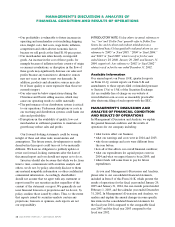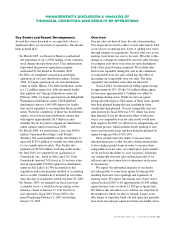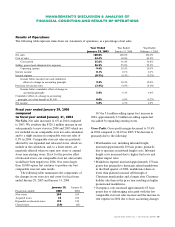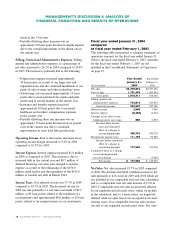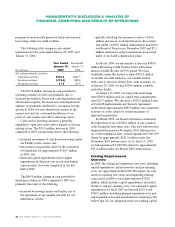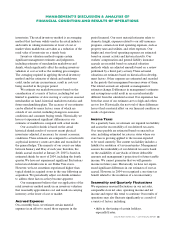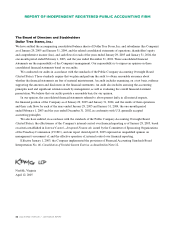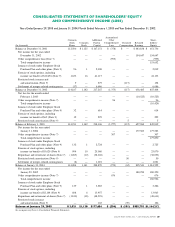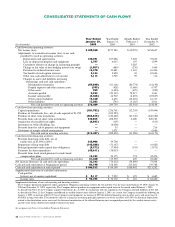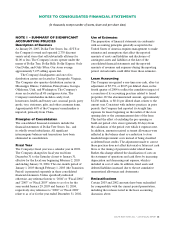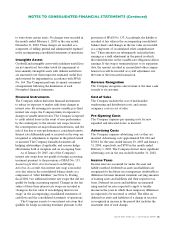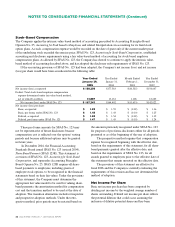Dollar Tree 2004 Annual Report Download - page 28
Download and view the complete annual report
Please find page 28 of the 2004 Dollar Tree annual report below. You can navigate through the pages in the report by either clicking on the pages listed below, or by using the keyword search tool below to find specific information within the annual report.
24 DOLLAR TREE STORES, INC. • 2004 ANNUAL REPORT
• the timing of new store openings;
• the net sales contributed by new stores;
• changes in our merchandise mix; and
• competition.
Our highest sales periods are the Christmas and
Easter seasons. Easter was observed on April 20, 2003,
April 11, 2004 and will be observed on March 27, 2005.
Due to the 16-day shorter Easter selling season in 2005,
we expect a smaller portion of our annual earnings to be
realized in the first quarter of 2005 as compared to 2004.
We generally realize a disproportionate amount of our net
sales and a substantial majority of our operating and net
income during the fourth quarter. In anticipation of
increased sales activity during these months, we purchase
substantial amounts of inventory and hire a significant
number of temporary employees to supplement our
continuing store staff. Our operating results, particularly
operating and net income, could suffer if our net sales
were below seasonal norms during the fourth quarter
or during the Easter season for any reason, including
merchandise delivery delays due to receiving or distri-
bution problems or consumer sentiment.
Our unaudited results of operations for the eight
most recent quarters are shown in a table in Footnote 13
of the Consolidated Financial Statements in Item 8 of
this Form 10-K.
Inflation and Other Economic Factors
Our ability to provide quality merchandise at a fixed price
and on a profitable basis may be subject to economic
factors and influences that we cannot control. Consumer
spending could decline because of economic pressures,
including rising gas prices. Reductions in consumer
confidence and spending could have an adverse effect on
our sales. National or international events, including war
or terrorism, could lead to disruptions in economies in
the United States or in foreign countries where we
purchase some of our merchandise. These and other
factors could increase our merchandise costs and other
costs that are critical to our operations, such as shipping
and wage rates.
Shipping Costs. In the past, we have experienced annual
increases of as much as 33% in our trans-Pacific shipping
rates due primarily to rate increases imposed by the trans-
Pacific shipping cartel. Currently, trans-Pacific shipping
rates are negotiated with individual freight lines and are
subject to fluctuation based on supply and demand for
containers and current fuel costs. We imported 19,612
forty-foot equivalent containers in 2004 and expect this
number to increase in fiscal 2005 proportionately to sales
growth. As a result, our trans-Pacific shipping costs in
fiscal 2005 may increase compared with fiscal 2004 when
we renegotiate our import shipping rates effective May
2005. We can give no assurances as to the amount of the
increase, as we are in the early stages of our negotiations.
Because of the increase in fuel costs throughout 2004
and the threat of continued increases in 2005, we expect
increased fuel surcharges from our domestic contract
carriers compared with past years. Based on current fuel
prices, we estimate that the costs resulting from increased
fuel surcharges may approximate $4.0 to $5.0 million in
2005. We expect to offset a portion of this potential
increase with improved operational efficiencies, including
improved routing and reduced distance between
distribution centers and the stores that they service.
Minimum Wage. Although our average hourly wage
rate is significantly higher than the federal minimum
wage, an increase in the mandated minimum wage could
significantly increase our payroll costs. In prior years,
proposals increasing the federal minimum wage by $1.00
per hour have narrowly failed to pass both houses of
Congress. However, if the federal minimum wage were
to increase by $1.00 per hour, we believe that our annual
payroll expenses would increase by approximately 40 basis
points, unless we realize offsetting cost reductions.
Leases for Replaced Distribution Centers. We are
liable for rent and pass-through costs under two leases
for now-closed distribution centers whose leases expire
in June 2005 and September 2005. We have recorded
charges to settle these estimated future obligations.
Unless offsetting cost savings are realized, adverse
economic factors, including inflation in operating
costs, could harm our financial condition and results
of operations.
New Accounting Pronouncements
In December 2004, the FASB issued SFAS No. 123
(revised 2004), Share-Based Payment (SFAS 123R). This
MANAGEMENT’S DISCUSSION & ANALYSIS OF
FINANCIAL CONDITION AND RESULTS OF OPERATIONS


